XX. 20th century Etruscans in tourist claws
Etruria, history and character
Before the founding of the Romans and the founding of the powerful Greek colonies of Magna, in northern Italy there was a mysterious village of the so-called Etruscans. Its territory was in the west of central Italy, upstream of the Tiber River, between the Tyrrhenian Sea and the Apennine Mountains. VII. C. By the twentieth century they were the owners of this extensive territory, which belonged to the cities of Clusium (Chiusi at present) and Tarquini (Tarquinia).
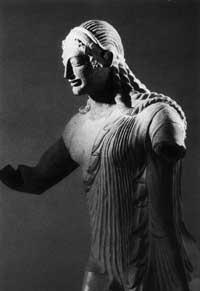
According to Herodotus, the Etruscans came from Asia Minor and the reason to move from there to those Italian lands was hunger. In fact, in the culture of the Etruscans there are many characteristics very similar to those of the Eastern cultures. The archaeological finds have also explained to us the close relations of the Etruscans with the oriental cultures. It does not seem, then, that Herodotus' statement is the fruit of imagination. In the collection of books “Origen de los Vascos”, by the Roncalés Beñat Estornes Lasa, we talk about the possible kinship between the “Etrusko-Basques”, but without great evidence.
Etruscans in Italy They appeared around 900 and dominated a wide area, quickly reaching Rome and Lazio, and to the south of Campania. In the North the Po valley and C. In 540 he seized Corsica. From a political point of view, a. C. In the fifth century they reached their greatest strength and diffusion. But as with the neighboring Celtic and Greek peoples they were in continuous romance, they had to meet Carthage. BC. In 474 they suffered a great defeat in Cumas against the army of Hieron I, tyrant of Sirakusa. Since then, the power of the Etruscans collapsed.
BC. In 396 the Romans seized the mighty city of Veyes, located north of Rome, and a. C. In 391 they reached Felina (present-day Bologna). Gradually all Etruria fell under the Roman claws. BC. IV. and III. As for centuries the rebellions against the Romans rose again and again, the Romans took revenge on the blood and fire, making the identity of the Etruscans disappear. The people, denationalized, without identity, went on, but not their cultures and languages, lost centuries later.
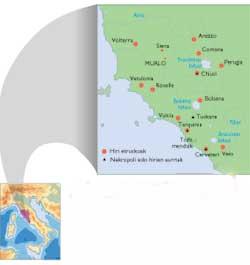
It is said that the alphabet used by the Etruscans was western Greece, and hence the Latin alphabet. Many of the inscriptions found could not be resolved until 1953. They believed in life after death, so numerous necropolis were held and the bumpy tombs that were built there were very famous.
His mythology was very cruel and bloody. In the field of art they loved music and dance. In the walls and pitchers were made figures of very vivid colors. Some of these pitchers, called “cannope”, were used to store the ashes of the dead. They liked portrait very much and in the field of architecture, their constructions can often be considered better than the Greeks. However, this town was disappearing as it lost its national identity, and today it is considered missing in all history books.
The discovery of contemporary Etruscans
Through an intense scientific study carried out in the laboratories of the universities of Turin (Italy) and Standford (United States) we have been able to know that those of Murlo, in northern Italy, are descendants of Etruscans. This village is located in northern Italy, near Siena, about 30 kilometers away, and it seems that its location owes it the isolation it had for centuries. Today it has an approximate population of 1,700 inhabitants and in the medieval old town live 25 people, all of them older. The oldest is Mrs. Armina, 83. So far he has not known that he was Etruscan. He was the first to give light to the hair and blood to Professor Alberto Piazza, who led the scientific team.
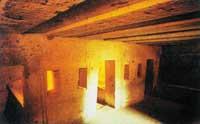
This group of scientists, consisting of professors, doctors, biologists, anthropologists, linguists and historians, worked under the direction of professors Alberto Piazza of the University of Turin and Luca Cavalli Sforza of the Standford University of California.
The first research began in 1988, and following the advice of anthropologists and linguists, 150 people of Muroan origin were examined with blood to investigate their DNA in depth. Of them murotones XX. The conclusion is that they are Etruscans of the twentieth century. In this blood test, in addition to taking into account the well-known groups A, B, 0, also worked known as RH, MNS, HP and HLA, as well as the ancient Etruscan corpses.
Genetic studies have shown that the Etruscans did not disappear under the rule of the Romans, but, after the loss of language and culture, they were completely Latinized. In some places, and over the years, they mingled with people from other peoples. But elsewhere, where the people of Murlo are the best witnesses, they have been able to remain ethnically clear for centuries, despite the loss of awareness of their identity and nationality.
New evolution of the Murlo community
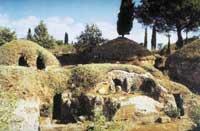
After these discoveries, the life of the Murotenses or, rather, of the neo-etruscans of Murlo has changed radically. Before Murlo was out of any tour, and now there are many. Those who come to Murlo to know the Etruscans of the twentieth century. And within this new tourism have seen well-known characters in the streets of Murlo
Their girls, proud to be Etruscans, do not want to have a relationship with the boys of Siena, at their side. “Before, yes,” they say, “but now no, because we have to defend history.” Yes. Now all the murlotarras feel Etruscan, and in the old castle of Murlín they have just located a beautiful Museum with old traces that have been found scattered throughout the village. The most outstanding image of these vestiges is the one made with roasted clay, under a hat of wide fin, in which you can see a beautiful face. This image has been considered the symbol of the village of Murlo and similar reproductions can be seen everywhere. All these traces were discovered in 1966 by students from Pensylvania University. In addition to these footprints, C. IV. A sort of 20th century palace was also discovered. And there they found in their entirety the ovens in which the Etruscans could manufacture their own jugs, plates, glasses, etc.
We must take into account the change that is taking place in the evolution of the personality of the murotarras, who feel the last of an “old people” (like the Murotic girls who do not want to have relationship with the Sienese boys).
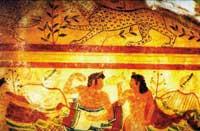
But in this life not everything is feeling, and the murotenses have begun to prepare their country to start from the benefits offered by tourism. For this reason, the characteristics of the ancient Etruscans have begun to “recover”, rather, while among them are “Etruscan dinners” and the Etrus clothing, where dance sessions are being put to the top. To do this, they place a long table in the ancient medieval Murozano enclosure and offer tourists a beautiful Etruscan menu: fried handles, toasted olive bread, goat cheese, herbal mass of the adjacent forests, mushrooms, quail of Ortigia, deer meat in sauce based on figs similar to those collected on the hill, and finally a cream cake.
All this accompanied by a rich “Etruscan” wine from the numerous vineyards of the area, although the ancient Etruscans still did not know.
New objectives of Sforza and Piazza
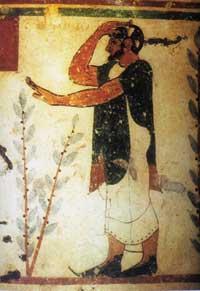
After discovering the Etruscan origin of the inhabitants of Murlo, the team of researchers under the direction of professors Luigi Cavalli-Sforza and Alberto Piazza has other projects. They seem to intend to do something about the origin of the Basques. According to the historians of this group, in Europe, before the Indo-European invasion from Asia, there was an itinerant hunter people who later disappeared into the hands of immigrants. The Basques are the last descendants of this people.
Sforza believes that from there come our remarkable genetic and linguistic differences with all Europeans. Their project would be to concretize it and for this, soon they will come to Euskal Herria to start their research. On the other hand, we must mention another great project of this group of researchers: Clarify the genetic structure of the entire European continent, in order to promote studies on different cultures. But that would be the cider of the other kupela.





